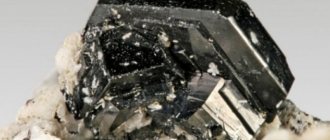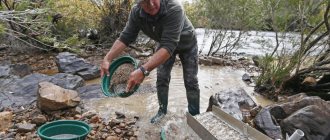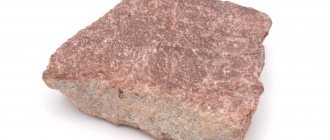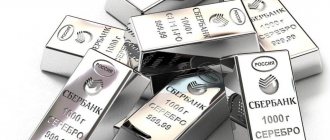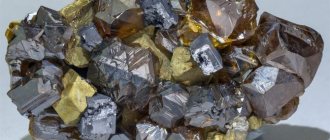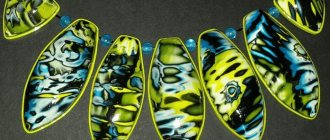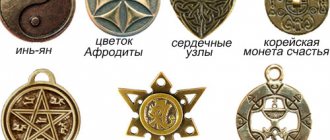History of the name apatite
Apatite has a Greek name, which means “deception.”
Indeed, this semi-precious stone can easily be confused with tourmaline, topaz, beryl, amethyst, diopside or aquamarine. Advertising - Continued below
Apatites are a group of phosphate minerals. The green-yellow stone is called asparagus stone in Spain. In Norway, sea-green apatites are found, and for this reason the stone is nicknamed moroxite.
Apatite. Photo: carionmineraux.com
Product price
The cost of souvenirs and jewelry made from apatite depends on several factors: the quality of the stone, the method of its processing, cutting, and related materials. For example, beads like in the photo, 40 cm long, cost between 1000-1500 rubles. The stone is not transparent, the cut is as simple as possible, the natural beauty and heterogeneity of the color of the mineral are preserved.
However, some apatites are quite expensive. In Ontario (Canada), a gem-quality mineral of green (sometimes with an admixture of blue or olive) color is mined. It is sold under the well-known trade name trilliumite. A 10-carat stone once cut is estimated to be worth over a thousand dollars.
Chemical and physical properties of apatite
The chemical formula of apatite is Ca10(PO4)6(OH,F,Cl)2. The formula changes depending on the amount of fluorine and chlorine contained in the mineral. Carbon dioxide in the carbonate group, as well as aluminum, manganese, strontium and thorium, can be identified as impurities.
Depending on the composition, the color of apatite also changes. Apatites come in green, blue, pink and yellow hues.
Advertising - Continued below
The mineral is very fragile and easily damaged. If apatite is moistened with sulfuric acid and set on fire, the flame will be bluish-green. The stone dissolves in nitric and sulfuric acid, as well as hydrogen chloride. It melts hard.
Apatite ores and prospects for their integrated use
Apatite ores and prospects for their integrated use
Phosphorus is the main component of industrially produced mineral fertilizers, and apatite is the main raw material source for its production in the Russian Federation. Deposits of apatite-containing ores are widespread in Russia, as well as in many foreign countries (South Africa, Brazil, Zimbabwe, etc.). Most of them are represented by complex ore deposits. In Russia, the main role in terms of reserves and production is played by the apatite-nepheline deposits of the Khibiny massif (Kola Peninsula), associated with ijolite-urtites, where they form a whole group of ore bodies with unique reserves. Elevated phosphorus concentrations occur in a variety of other types of igneous, metamorphogenic and exogenous deposits. The largest deposits of apatite ores are of endogenous origin and are spatially and genetically associated with intrusions of nepheline syenites, ultrabasic-alkaline rocks with carbonatites, and alkali-gabbroid formations. Accumulations of apatite-ilmenite-titanomagnetite ores are also known in ultramafic massifs of the normal series. Significant apatite deposits are associated with metamorphic complexes and weathering crusts, developed mainly on carbonatites.
The P2/O5 content in ores of various industrial genetic types varies widely (0.4-36.7%). The most stable phosphorus content is characteristic of the Khibiny apatite-nepheline ores, from which for almost seventy years an apatite concentrate has been obtained, characterized by a stable chemical composition (P2/O5 greater than or = 39.4%; CaO 50.4%; Sr0 2.5-3.0%, TR2/ O3 0.8-1.0%; F 3%). The second fairly reliable object for obtaining apatite concentrate is the Kovdor deposit of apatite-magnetite ores, which belongs to the formation of ultrabasic alkaline rocks with carbonatites, which has been exploited since 1962. In Russia, almost 90% of apatite is obtained from apatite-nepheline ores, and about 10% from apatite-magnetite ores. %. About 0.2% of apatite was extracted in 1990 from apatite-ilmenite-titanomagnetite ores in gabbroids (Volkovskoe deposit, Ural). All other types of ores are considered promising, the exploitation of which is quite realistic as needed. In terms of scale, most of them belong to the category of large deposits, the reserves of which amount to hundreds of millions of tons of P2/O5 (Sokolov A.S., 1996).
Almost all types of apatite ores are complex raw materials, because In addition to phosphorus, they contain Al, Fe, Ti, TR, Sr, F, Zr, Nb and other valuable components. It is also necessary to evaluate the content of rare earth elements (REE) in apatites from various industrial genetic types in connection with the possibility of their isolation into an independent product during the nitric acid technology of processing phosphate raw materials. The belonging of apatite to rocks of various igneous formations is reflected in the level of REE content in apatite. The amount of TR is minimal in apatite of gabbro-diorite-diabase and pyroxenite-gabbro formations (0.1-0.2%). Apatite of the gabbro-anorthosite formation is characterized by higher TR values (up to 0.5%). The maximum REE contents are established in apatite from apatite nepheline syenites and carbonatites (usually up to 1%). The formational identity of the rocks from which apatite is isolated also affects the composition of the rare earth elements contained in it. If apatite from alkaline rocks of the formation of apatite nepheline syenites (Khibiny) and carbonatites (Kovdor and others) is characterized by a selective cerium REE composition, then apatite from mafic formations is characterized by a less contrasting ratio of these elements. Apatite from ore gabbroids of the gabbro-anorthosite formation is characterized by the most clearly defined europium minimum. This feature is clearly reflected in the values of europium anomalies (Eu/Eu-x), i.e. in the ratio of the europium content in the apatite sample to the europium content in the chondrite. For apatites from gabbro-anorthosite complexes, as well as metamorphogenic deposits, the value of europium anomalies is always less than one. Rare earths, as well as Y, U, Th, are constantly contained in apatite isolated from ores of Precambrian metamorphic complexes (up to 1.3% TR). In the apatite of the Aldana metamorphic complexes, light lanthanides also play a predominant role. In general, they have an increased La/Yb ratio. The maximum values of the La/Yb ratio are characteristic of apatite from apatite-nepheline ores (242), from syenite-diorites (145) and from carbonatites (105). The highest concentrations of yttrium(Y) were noted by D.A. Mineev in apatite from apatite-nepheline ores (up to 0.054%) and carbonatites (up to 0.059%). In the apatite of the Aldan metamorphic rocks the yttrium content reaches 0.019%, in the Seligdar apatite it averages 0.03%.
A permanent impurity in apatite is strontium (Sr). Its highest contents are typical for apatite from ores of apatite-nepheline deposits. In apatite of metamorphogenic deposits (Seligdar), up to 0.53% Sr was found. Apatite from complex deposits of gabbroic formations usually contains up to 0.07% Sr.
A useful component for apatite of all industrial-genetic types of apatite deposits is fluorine, the amount of which is usually 2-4%. Of some interest may be thorium (Th), the content of which in apatites is at the level of 0.00n - 0.0n%. There is slightly more thorium in apatite of metamorphogenic deposits (0.02 - 0.06%; it also contains 0.005 - 0.007% uranium and up to 0.0005% Sc.
In addition, the ores of most apatite-containing endogenous deposits (Khibiny, Kovdor, etc.), as well as ores of weathering crusts developed on carbonatite massifs (White Winter, etc.) contain a number of useful minerals (titanium magnetite, magnetite, ilmenite, sphene, nepheline, tantalum-niobates, baddeleyite, etc.), which can be isolated into independent concentrates of industrial importance. However, even for such a giant as OJSC Apatit, the extraction of minerals from ore supplied to processing plants does not exceed 40%.
A constant companion of apatite in complex ores is titanomagnetite. Based on TiO2 content, three varieties are distinguished: low-titanium (1-4%), medium-titanium (5-9%) and high-titanium (10-20%), which is most typical for magmatic apatite deposits. In addition to titanium, titanomagnetite contains 0.08% V; 0.2-1.6% Mn; up to 0.004% Sc; up to 0.006% Ga. In addition, Md, Cr, Ni, and Co were found in it. These same ores often contain ilmenite, which is separated into a separate concentrate. This especially applies to complex ores of gabbro-diorite-diabase (Kopanskoye and other deposits) and gabbro-anorthosite (Bolshoy Seyim and others) formations. Ilmenite contains 0.005-0.01% Sc as useful impurities; 0.05-0.2% V; 0.007 - 0.04% Nb; 0.02 - 0.08% Zr, etc.
For apatite-ilmenite-titanomagnetite ores, the copper minerals they contain (bornite and chalcopyrite) are of significant interest. The average Cu content in the ores of the Volkovsky deposit is 0.5 - 0.6%.
Of practical interest are selenium and tellurium present in the copper concentrate of this deposit.
For apatite-nepheline ores, an important component is nepheline, the concentrate of which is used at factories in the Russian Federation (Volkhovsky, Pikalevsky) to produce alumina, soda, potash, cement, and gallium. In addition to Al2/O3 (28 - 28.5%), the concentrate contains 0.004-0.006% Ga; 0.015-0.02% Rb; up to 0.0004% Cs (according to D.A. Mineev). From apatite-nepheline ores, a sphene concentrate can be obtained, in which, in addition to TiO2 (31.7% after chemical enrichment), there are (wt.%): 0.3% (Nb1/Ta)2/O5; 0.15% ZrO2 0.4% Tr2/Oz; 0.3% SrO. From these ores it is possible to produce titanomagnetite and pyroxene concentrates containing up to 0.2-0.3% V.
From the apatite-magnetite ores of the Kovdor carbonatites, baddeleyite concentrate is obtained along the way, which contains an increased amount of scandium (0.05-0.06%). From ores of weathering crusts developed on carbonatites, it is possible to obtain concentrates of francolite and minerals of niobium, titanium, and rare earths (pyrochlore, monazite, xenotime, rutile, ilmenite, etc.). Many of these minerals are characterized by high scandium content (up to 0.1-0.2% Sc). A typical example of such deposits is Tomtor in Yakutia, whose ores are twice as rich in niobium and rare earths as the richest deposits in the world (Arasha in Brazil and Mountain Pass in the USA, respectively). Rare metal concentrates obtained from Tomtor ores are promising for the associated production of scandium.
There are several directions for increasing the integrated use of apatite ores. Firstly, all useful components from apatite concentrates themselves (rare earths, strontium, fluorine, etc.) are still not completely extracted. Currently, phosphorus is mainly extracted from apatite; the remaining components are lost during the chemical processing of raw materials. For example, with the extraction method of producing phosphoric acid (dihydrate process), for each ton of apatite concentrate, 1.6 tons of phosphogypsum are formed, with the dumps of which Ca, Sr, TR, part of phosphorus and F are irretrievably lost. At the same time, with the complex nitric acid method of processing apatite concentrate, according to research by Dmitrevsky B.A., Goldinov A.L., Kopylev B.A., Abramov O.B. etc., almost complete extraction of all its components is possible. Considering the stable composition of apatite, it can be predicted that with current volumes of concentrate production, the extraction of Sr, TR, F from it can cover the needs for these elements for many industries and be an export item. According to expert estimates, from 1 million tons of apatite concentrate, 15-20 thousand tons of fluoride salts, 12-15 thousand tons of strontium salts and 6-8 thousand tons of rare earth salts can be obtained.
Secondly, it is necessary to improve the quality of concentrates, because the amount of impurity minerals in them is usually 20-30%, i.e. the composition of the concentrates is very far from the chemical composition of the minerals for which they are extracted.
We should also dwell on the problem of complex processing of poor and substandard apatite-nepheline ores located at great depths (below zero). In the Khibiny apatite deposits, with the transition to mining of deep horizons, the content of apatite is constantly decreasing, and nepheline, pyroxene, sphene, and titanomagnetite are increasing. For example, the Eveslogchorr deposit, which lies at elevations of 300-1000 m, is poor in apatite content. With the traditional method of underground mining for OJSC Apatit, the normalized losses of ore will be very large, and the production of individual concentrates will become unprofitable. In this regard, new approaches are needed that combine the technology of extraction, enrichment and chemical processing of raw materials directly at the deposit. A promising method of underground disintegration leaching, based on the selective dissolution of apatite and nepheline in dilute solutions of mineral acids, with the supply of a solvent through underground mine workings passed under blocks with ore crushed to a given size piece, seems promising. The erosion of the area prepared for leaching should be carried out from the bottom up through a specially prepared bottom of the block with dilute solutions of nitric acid (3 - 5% HNO3) with hydrotransportation of the pulp to the surface in the workshop for its processing. The pulp, containing apatite and nepheline dissolved in acid and minerals insoluble in HNO3 (feldspar, sphene, titanomagnetite, ilmenite, pyroxene, etc.), can be processed according to a scheme that allows achieving almost complete extraction of all valuable components of the ore.
Thus, in the future there are broad opportunities for expanding the integrated use of apatite ores, which can follow both the path of the most complete use of the composition of apatite itself, the production and processing of accompanying minerals, and the path of creating a new technology for processing minerals directly in the subsoil.
Application of apatite
Despite the similarity of apatite to precious stones, jewelers almost never use this stone to make jewelry. Due to its low density, the stone is easy to damage and quickly loses its attractiveness. Typically, jewelry with apatite is of interest to collectors, and this stone is mainly used in necklaces and pendants.
Most often, apatite is used in the agricultural industry for the production of fertilizers, as well as in metallurgical, glass and ceramic production.
Bracelet with apatite. Photo: notonthehighstreet.com
Use in agriculture
It has long been known that apatites are fertility minerals, so their main area of application is agriculture. Phosphorus is one of the main components of a chemical compound, as mentioned above. As you know, this element is vital not only for humans, but also for plants. Phosphorus is a building material for living organisms; it takes part in many biological processes.
Apatites are minerals that are the starting product for the production of natural mineral phosphorus fertilizers. Raw materials have been used for this purpose for a very long time. Since the beginning of the 20th century, many mineral processing plants have been built and are operating. One of the largest is the Khibiny Apatit plant, which was put into operation in 1929 on the basis of the world’s largest deposit.
Magical and healing properties of apatite
This unusual, deceptive mineral is energetically “attached” to a person from the first days. It is not recommended to give it as a gift, because... he will quickly lose his attractiveness and simply die, while he can harm the new owner. If you want to take off your jewelry with apatite, you should do it immediately.
Advertising - Continued below
At the same time, this stone is a true devoted friend, capable of promptly pointing out illnesses. If the stone has been shiny for a long time, but has suddenly become dull, the owner should be examined in a medical facility. Apatite is a very good indicator of health.
People who wear apatite may have prophetic dreams. The stone can warn of impending failures and help prevent bad luck.
